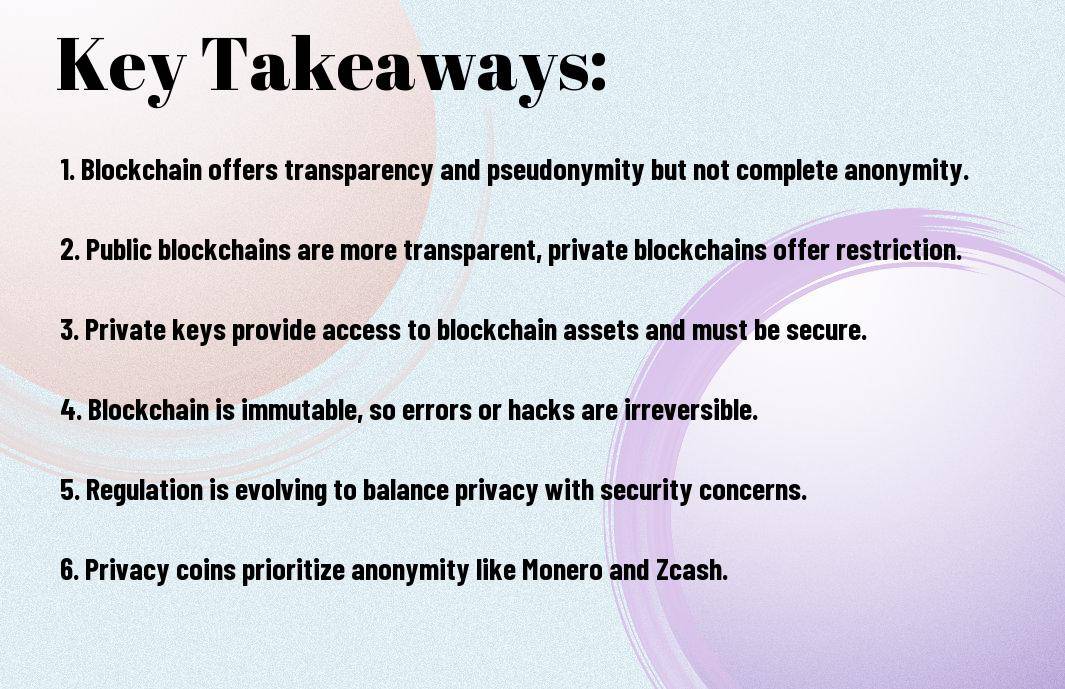
Newsletter Subscribe
Enter your email address below and subscribe to our newsletter

Enter your email address below and subscribe to our newsletter

Privacy and Security in the Blockchain! Over the past few years, Blockchain technology has revolutionized the way we store and transfer data. As this technology becomes more prevalent in various industries, it is crucial to understand the implications it has on privacy and security. In this blog post, we will investigate into the key aspects of privacy and security in the Blockchain and provide you with necessary information to navigate this complex landscape. For a deep investigate how Blockchain interacts with data privacy, check out this Blockchain and Data Privacy article.


Even with the increased attention on blockchain technology, many individuals still struggle to grasp the fundamental concepts underlying it. In this chapter, we will break down the basics of blockchain technology and research into the different types of blockchain networks.
One of the key features of blockchain technology is its decentralized nature, which means that it operates on a network of computers rather than a central server. This distributed ledger system records transactions across a network of computers, providing transparency, security, and immutability.
Types of blockchain networks can be categorized into public, private, and consortium blockchains. Public blockchains, such as Bitcoin and Ethereum, are open to anyone and offer a high level of transparency. Private blockchains restrict access to authorized participants, offering more control and privacy. Consortium blockchains are operated by a group of organizations, balancing the benefits of both public and private blockchains.
| Public Blockchains | Private Blockchains |
| – Open to anyone | – Restricts access |
| – Highly transparent | – Offers more control |
| – Decentralized | – More privacy |
| – Immutable | – Limited access |
| – Offers security | – Controlled by a single entity |
With the increasing adoption of blockchain technology across various industries, understanding the different types of blockchain networks becomes crucial. Public blockchains are ideal for applications requiring transparency and decentralization, while private blockchains are suitable for organizations seeking more control and privacy.
| Consortium Blockchains | Hybrid Blockchains |
| – Operated by a group of organizations | – Combines features of public and private blockchains |
| – Shared control | – Offers flexibility |
| – Enhanced security | – Customizable permissions |
| – Allows for collaboration | – Scalable |
| – Balances transparency and privacy | – Adaptability |
Despite the common misconception that blockchain technology provides complete anonymity, it actually offers pseudonymity. This means that while users are represented by cryptographic addresses rather than their real identities, all transactions are recorded on the blockchain and are accessible to the public. This level of transparency can provide a certain amount of privacy, but it also means that individuals can be identified through their transaction history if their blockchain address is linked to their identity.
Blockchain technology offers pseudonymity, which allows users to keep their real identities hidden behind cryptographic addresses. However, this does not guarantee complete anonymity as all transactions are recorded on the public ledger. While this can provide a level of privacy, it’s important to understand that transactions can be traced back to individuals if their blockchain address is ever linked to their real-world identity.
Any information that is entered onto a blockchain is immutable and transparent, meaning that once it is recorded, it cannot be altered or deleted. This permanence can pose challenges for privacy, especially when dealing with sensitive data. However, there are strategies and technologies being developed to enhance privacy on the blockchain, such as zero-knowledge proofs and ring signatures. These tools allow for transactions to be verified without revealing any sensitive information, thereby increasing privacy for users.
It is crucial for individuals and businesses utilizing blockchain technology to be aware of these privacy considerations and to implement appropriate measures to protect their data. Understanding the limitations of pseudonymity and exploring ways to enhance privacy on the blockchain can help safeguard sensitive information and maintain confidentiality.

For the security of a blockchain network, cryptographic techniques play a vital role. Blockchain relies on cryptographic hash functions for creating secure digital signatures, ensuring data integrity, and encrypting sensitive information. These techniques make it virtually impossible for unauthorized parties to alter recorded transactions without detection.
To maintain the security and integrity of data on a blockchain, consensus mechanisms are crucial. Consensus algorithms like Proof of Work (PoW) and Proof of Stake (PoS) ensure that all participants agree on the validity of transactions. PoW requires nodes to solve complex mathematical puzzles to add new blocks to the chain, while PoS selects validators based on the amount of cryptocurrency they hold.
Plus, it’s important to note that the consensus mechanism directly impacts the security of a blockchain network. Weak consensus mechanisms can make a blockchain vulnerable to attacks, like 51% attacks or double-spending. It is crucial for blockchain developers to carefully choose or design a consensus mechanism that aligns with the security requirements of the network.
Unlike Blockchain And Data Privacy: The Future Of Technology Compliance, blockchain technology is not immune to vulnerabilities and risks. It is important to understand and address these factors to maintain the security and integrity of blockchain networks.
Attack vectors in blockchain networks can range from traditional cyber threats like phishing attacks to more sophisticated techniques such as 51% attacks and Sybil attacks. A 51% attack occurs when a single entity controls the majority of the network’s mining power, enabling them to manipulate the blockchain. On the other hand, a Sybil attack involves creating multiple fake identities to gain control over the network.
Common strategies to mitigate security risks in blockchain networks include implementing multi-factor authentication, encryption, and regular security audits. It is crucial for organizations to continuously update their security measures to stay ahead of evolving threats and vulnerabilities. By prioritizing security protocols and fostering a culture of vigilance among users, blockchain networks can enhance their resistance to potential attacks.
Your understanding of privacy regulations across the globe is crucial when dealing with blockchain technology. Global data protection laws such as the European Union’s General Data Protection Regulation (GDPR) and the California Consumer Privacy Act (CCPA) have a significant impact on how data is handled and stored on the blockchain. These regulations emphasize the importance of transparency, accountability, and the rights of individuals to control their personal information.
One of the biggest challenges facing organizations utilizing blockchain technology is compliance with existing regulations. One must navigate a complex regulatory landscape to ensure that the technology is used in a way that is both legal and ethical. This involves understanding how data on the blockchain is handled, ensuring appropriate security measures are in place, and implementing mechanisms for data protection and privacy.
To stay compliant with regulations, organizations need to understand the specific requirements of the jurisdictions in which they operate. Failure to comply with these regulations can result in hefty fines, legal consequences, and damage to reputation. Organizations need to prioritize compliance as an integral part of their blockchain strategy to build trust with users and regulators alike.

Future advancements in cryptography will play a crucial role in enhancing the privacy and security mechanisms of blockchain technology. Innovations such as zero-knowledge proofs, homomorphic encryption, and multi-party computation are likely to become more prevalent in the blockchain space. These advanced cryptographic techniques allow for secure and private transactions without revealing sensitive information, making it harder for malicious actors to exploit vulnerabilities in the system.
With the increasing adoption of blockchain technology, there are both potential developments and emerging threats to be aware of. On one hand, the widespread use of blockchain can lead to improved transparency, increased efficiency, and reduced costs in various industries. However, it also opens doors to new security challenges such as quantum computing threats, 51% attacks, and smart contract vulnerabilities. It is crucial for developers and users to stay vigilant and continuously adapt to these evolving threats to maintain the integrity of the blockchain ecosystem.
Cryptography plays a pivotal role in safeguarding data and ensuring the trustworthiness of blockchain transactions. However, as cryptographic techniques advance, so do the tools and resources available to malicious actors. It is imperative for organizations to regularly update their cryptographic protocols and incorporate the latest security measures to mitigate risks and protect sensitive information.
Drawing together the concepts of privacy and security in the blockchain reveals a complex system that offers both benefits and challenges. While the decentralized nature of blockchain ensures data integrity and transparency, it also poses risks to privacy due to the permanence of transactions. Understanding the mechanisms behind blockchain security is imperative in navigating this technology safely. For a deeper investigate blockchain security, check out Blockchain security: Everything you should know for safe use.
A: Blockchain technology is a decentralized, distributed ledger that records transactions across multiple computers in a secure and transparent way.
A: Privacy in blockchain is maintained through cryptographic techniques like encryption and hashing, which secure data and ensure only authorized parties have access.
A: Blockchain offers benefits such as immutability, transparency, and decentralization, which can enhance security by reducing the risk of data tampering and unauthorized access.
A: Personal data can be kept private on the blockchain through techniques like zero-knowledge proofs and private transactions, which allow for anonymity while still ensuring data integrity.
A: Blockchain technology can help protect against cyber attacks by eliminating single points of failure, making it more difficult for hackers to compromise data or launch a successful attack.
A: Security concerns with blockchain include vulnerabilities in smart contracts, private key management, scalability issues, and the potential for 51% attacks on certain blockchain networks.
A: Individuals can protect their privacy when using blockchain-based applications by being cautious with the information they disclose, securing their private keys, using hardware wallets, and staying informed about potential security risks.